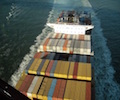

Asia to US prices continued an inexorable surge through until mid-September reaching a high of $20,586/FEU on FBX01 into the West Coast, and $22,173/FEU into the East Coast. Since then, the market has started to taper off significantly triggered by announcements by Hapag Lloyd and CMA CGM they will put an absolute cap on their spot rates. Price action by other carriers remained fairly stable.
However, this has pulled the front of the forward curves down since the start of the month – FBX01 Q421 now sits lower on value at $20,000 – this is still a premium above the current spot -price on the expectation that the market will remain tight until the end of the year. FBX03 tracked this, with the premium into the East Coast hovering between $1,500-$2,000/FEUs
On Asia-Europe and Mediterranean trades, spot prices have softened slightly. However, price discipline in terms of the spread of spot rates versus the index prices remains much stronger than the Asia-US route. –Generally speaking, a premium of $1,500 into the UK has held true since the original troubles at ports such as Felixstowe at the start of the year, creating basis risk between the European ports.
Action on the forward market has been driven largely by substantially increases interest and demand for FFAs. Periods inside of 2022 have gradually pushed up through the month, the full FBX11 Cal22 offered in at $10,500 with the anecdotal base rate for a Cal22+23+24 closer to $5,000 – the 2020 average for FBX11 was $2,026. This substantial increase hits the market at a time when contracts on the route are starting to refresh, with assessments that an increased contract base rate will lead to inflation of prices for consumers globally. Much of the selling interest on the forward market has started to stretch out all the way through to 2025 as capacity owners look to lock-in freight prices further disrupting what remains an extremely complex and challenging physical market.
Source: Peter Stallion, Head of Air and Containers, Freight Investor Services